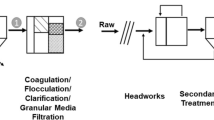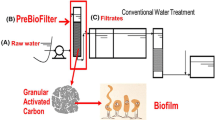Abstract
Filtration using biological activated carbon (BAC) performs well in the removal of biodegradable dissolved organic carbon from water sources. The application of ozonation followed by up-flow BAC filtration has gained increasing attention in the world scale. In this study, a pilotscale up-flow BAC filtration system was constructed for the treatment of polluted lake water. The operational results indicated that this BAC filtration system could effectively remove organic matter. Spatial heterogeneity of the microbial community structure inside the BAC filtration system was identified using bacterial 16S rRNA clone library analysis. A marked decrease of microbial diversity in the BAC filtration system was observed along the flow path. Alphaproteobacteria, Gammaproteobacteria and Acidobacteria were found to be the major bacterial groups in the BAC filters. Moreover, Novosphingobium aromaticivorans-like microorganisms were detected. This work might add some new insights towards microbial communities in regards to BAC filtration for the treatment of drinking water.
Similar content being viewed by others
References
Magic-Knezev, A. and D. van der Kooij (2004) Optimisation and significance of ATP analysis for measuring active biomass in granular activated carbon filters used in water treatment. Water Res. 38: 3971–3979.
Boon, N., B. F. G. Pycke, M. Marzorati, and F. Hammes (2011) Nutrient gradients in a granular activated carbon biofilter drives bacterial community organization and dynamics. Water Res. 45: 6355–6361.
Li, X., G. Upadhyaya, W. Yuen, J. Brown, E. Morgenroth, and L. Raskin (2010) Changes in the structure and function of microbial communities in drinking water treatment bioreactors upon addition of phosphorus. Appl. Environ. Microbiol. 76: 7473–7481.
Stewart, M. H., R. L. Wolfe, and E. G. Means (1990) Assessment of bacteriological activity associated with granular carbon treatment of drinking water. Appl. Environ. Microbiol. 56: 3822–3829.
Ko, Y. S., Y. J. Lee, and S. H. Nam (2007) Evaluation of a pilot scale dual media biological activated carbon process for drinking water. Kor. J. Chem. Eng. 24: 253–260.
Magic-Knezev, A., B. Wullings, and D. Van der Kooij (2009) Polaromonas and Hydrogenophaga species are the predominant bacteria cultured from granular activated carbon filters in water treatment. J. Appl. Microbiol. 107: 944–953.
Niemi, R. M., I. Heiskanen, R. Heine, and J. Rapala (2009) Previously uncultured β-Proteobacteria dominate in biologically active granular activated carbon (BAC) filters. Water Res. 43: 5075–5086.
Kasuga, I., D. Shimazaki, and S. Kunikane (2007) Influence of backwashing on the microbial community in a biofilm developed on biological activated carbon used in a drinking water treatment plant. Water Sci. Technol. 55: 173–180.
Soonglerdsongpha, S., I. Kasuga, F. Kurisu, and H. Furumai (2011) Comparison of assimilable organic carbon removal and bacterial community structures in biological activated carbon process for advanced drinking water treatment plant. Sustain. Environ. Res. 21: 59–64.
Pang, C. M. and W. T. Liu (2006) Biological filtration limits carbon availability and affects downstream biofilm formation and community structure. Appl. Environ. Microbiol. 72: 5702–5712.
Simpson, D. R. (2008) Biofilm processes in biologically active carbon water purification. Water Res. 42: 2839–2848.
China Environmental Protection Agency (2002) Methods for water and wastewater determination. China Environmental Science Press, Bei**g.
Huang, Y., L. Zou, S. Y. Zhang, and S. G. **e (2011) Comparison of bacterioplankton communities in three heavily polluted streams in China. Biomed. Environ. Sci. 24: 140–145.
Wang, Q. F., S. Y. Zhang, L. Zou, and S. G. **e (2011) Impact of anthracene addition on microbial community structure in soil microcosms from contaminated and uncontaminated sites. Biomed. Environ. Sci. 24: 543–549.
Schloss, P. D. and J. Handelsman (2005) Introducing DOTUR, a computer program for defining operational taxonomic units and estimating species richness. Appl. Environ. Microbiol. 71: 1501–1506.
Wang, Q., G. M. Garrity, J. M. Tiedje, and J. R. Cole (2007) Naïve Bayesian classifier for rapid assignment of rRNA sequences into the new bacterial taxonomy. Appl. Environ. Microbiol. 73: 5261–5267.
**e, S. G., W. M. Sun, C. L. Luo, and A. M. Cupples (2010) Stable isotope probing identifies novel m-xylene degraders in soil microcosms from contaminated and uncontaminated sites. Water Air Soil Pollut. 212: 113–122.
Moll, D. M., R. S. Summers, and A. Breen (1998) Microbial characterization of biological filters used for drinking water treatment. Appl. Environ. Microbiol. 64: 2755–2759.
Vaz-Moreira, I., O. C. Nunes, and C. M. Manaia (2011) Diversity and antibiotic resistance patterns of Sphingomonadaceae isolates from drinking water. Appl. Environ. Microbiol. 77: 5697–5706.
Inoue, D., S. Hara, M. Kashihara, Y. Murai, E. Danzl, K. Sei, S. Tsunoi, M. Fujita, and M. Ike (2008) Degradation of Bis(4-Hydroxyphenyl)methane (bisphenol F) by Sphingobium yanoikuyae strain FM-2 isolated from river water. Appl. Environ. Microbiol. 74: 352–358.
Padgett, K. A., C. Selmi, T. P. Kenny, P. S. C. Leung, D. L. Balkwill, A. A. Ansari, R. L. Coppel, and M. E. Gershwin (2005) Phylogenetic and immunological definition of four lipoylated proteins from Novosphingobium aromaticivorans, implications for primary biliary cirrhosis. J. Autoimmun. 24: 209–219.
Bogdanos, D. P. and D. Vergani (2009) Bacteria and primary biliary cirrhosis. Clin. Rev. Allergy Immunol. 36: 30–39.
Author information
Authors and Affiliations
Corresponding author
Rights and permissions
About this article
Cite this article
Liao, X., Chen, C., Chang, CH. et al. Heterogeneity of microbial community structures inside the up-flow biological activated carbon (BAC) filters for the treatment of drinking water. Biotechnol Bioproc E 17, 881–886 (2012). https://doi.org/10.1007/s12257-012-0127-x
Received:
Revised:
Accepted:
Published:
Issue Date:
DOI: https://doi.org/10.1007/s12257-012-0127-x




